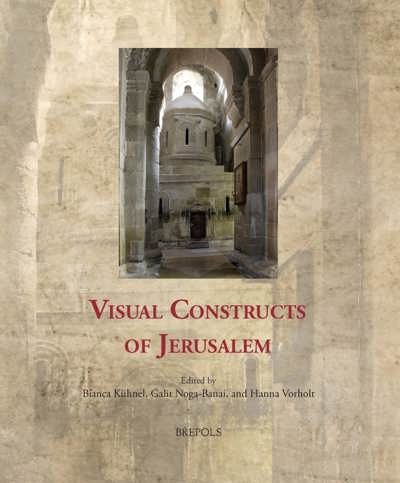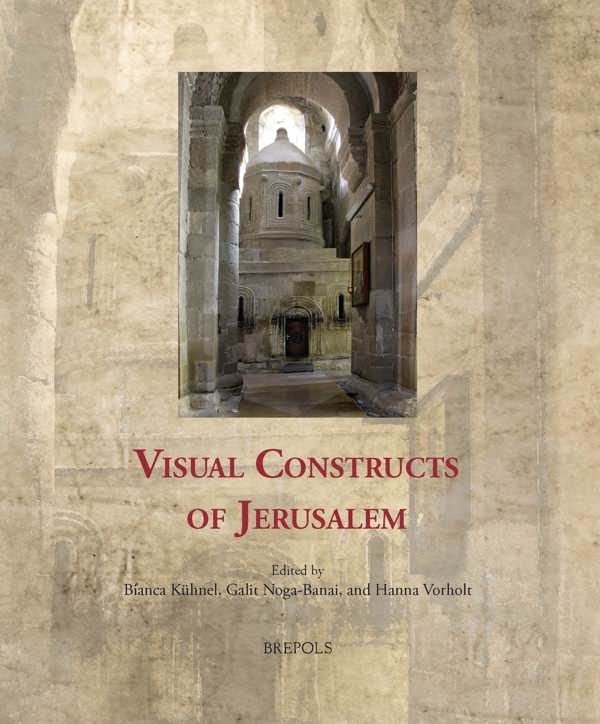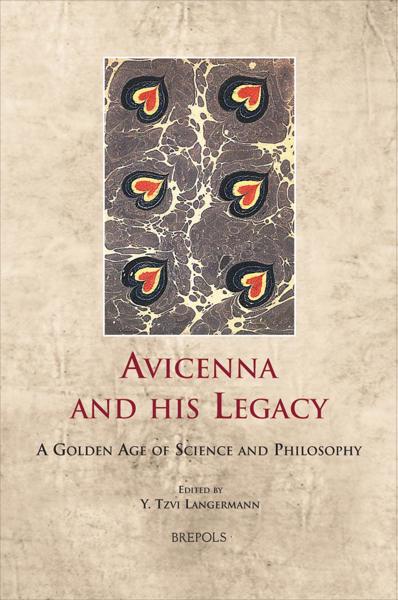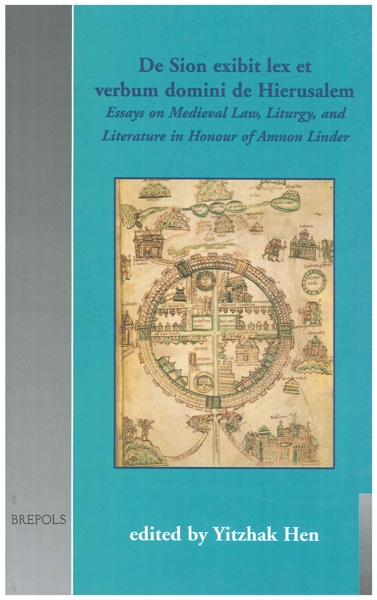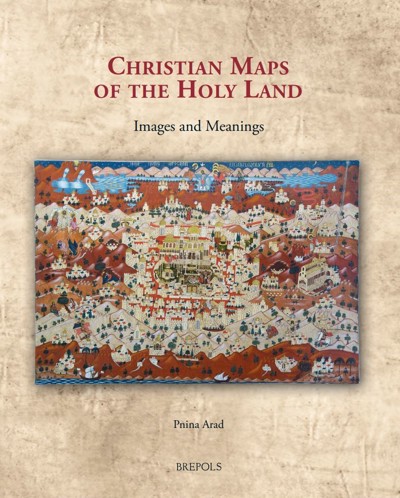
Visual Constructs of Jerusalem
Bianca Kühnel, Galit Noga-Banai, Hanna Vorholt (eds)
- Pages: xxxviii + 492 p.
- Size:216 x 280 mm
- Illustrations:254 b/w, 24 col.
- Language(s):English
- Publication Year:2015
- € 180,00 EXCL. VAT RETAIL PRICE
- ISBN: 978-2-503-55104-3
- Paperback
- Available
- € 180,00 EXCL. VAT RETAIL PRICE
- ISBN: 978-2-503-55121-0
- E-book
- Available
This volume marks a turning point in demonstrating the visuality of Jerusalem as a rich reservoir of sources and insights in dialogue with other disciplines.
"Visual Constructs of Jerusalem (...) fills an important gap in our knowledge by analyzing how Jerusalem was constructed, primarily in Europe, from Late Antiquity to today with the focus on the Middle Ages and the Early Modern period. (...) While scholars, including many of the authors of this volume, have already done much to shed light on this topic, this is by far the most comprehensive, in-depth, and original treatment to date. (...) this volume is an important milestone to which a wide variety of scholars--all those with an interest in medieval or early modern art and medieval or early modern Christianity--will undoubtedly be turning frequently and for a very long time." (Elizabeth Lapina, in: The Medieval Review, 15.10.04)
"(...) this impressive collection is a valuable addition to the library of any historian or art historian, and it is particularly noteworthy for its pedagogical value and the many avenues it encourages for further scholarly inquiries." (Alice Isabella Sullivan, in: Parergon 32.2, 2015, p. 324-325)
«(…) ce volume, d’une richesse exceptionnelle, est une contribution majeure à l’étude de questions fondamentales pour l’art et la pensée du christianisme (…) cet ouvrage est également un dossier exceptionnel par l’abondance de la matière présente dans ces travaux, comme par la densité des références fournies dans les notes. La clarté du plan d’ensemble, et la présence de l’index, en font un instrument de travail exemplaire.» (Christian Heck, dans le Bulletin Monumental 174.2, 2016, p. 231)
"Die höchst stimulierende, mit reichem Bildmaterial und Register bestens aufbereitete Publikation beeindruckt nicht zuletzt durch die Breite der erfassten Themen, die der visionären Kraft der Hgg. zu verdanken ist." (Ingrid Baumgärtner, in: Das Mittelalter, 21(1), 2016, p. 221-223)
The special position of Jerusalem among the cities of the world stems from a long history shared by the three Abrahamic religions, and the belief that the city reflected a heavenly counterpart. Because of this unique combination, Jerusalem is generally seen as extending along a vertical axis stretching between past, present, and future. However, through its many ‘earthly’ representations, Jerusalem has an equally important horizontal dimension: it is represented elsewhere in all media, from two-dimensional maps to monumental renderings of the architecture and topography of the city’s loca sancta.
In documenting the increasing emphasis on studying the earthly proliferations of the city, the current book witnesses a shift in theoretical and methodological insights since the publication of The Real and Ideal Jerusalem in Jewish, Christian, and Islamic Art in 1998. Its main focus is on European translations of Jerusalem in images, objects, places, and spaces that evoke the city through some physical similarity or by denomination and cult - all visual and material aids to commemoration and worship from afar. The book discusses both well-known and long-neglected examples, the forms of cult they generate and the virtual pilgrimages they serve, and calls attention to their written and visual equivalents and companions. In so doing, it opens a whole new vista onto the summa of representations of Jerusalem.
Introduction — BIANCA KÜHNEL, GALIT NOGA-BANAI, HANNA VORHOLT
Loca sancta: Formation and Accumulation of Traditions
‘Remembering Sion’: Early Medieval Latin Recollections of the Basilica on Mount Sion and the Interplay of Relics, Tradition, and Images — THOMAS O’LOUGHLIN
Mary in Jerusalem: An Imaginary Map — ORA LIMOR
Lavit et venit videns: The Healing of the Blind Man at the Pool of Siloam — BARBARA BAERT
Patronage Contested: Archaeology and the Early Modern Struggle for Possession at the Church of the Nativity, Bethlehem — JORDAN PICKETT
From Biblical to Non-Biblical Holy Places: The Shrine of Subiaco as a Construct of Jerusalem — ALESSANDRO SCAFI
Monumental Translations
How Mtskheta Turned into the Georgians’ New Jerusalem — TAMILA MGALOBLISHVILI
Locative Memory and the Pilgrim’s Experience of Jerusalem in the Late Middle Ages — MICHELE BACCI
New Research on the Holy Sepulchre at the ‘Jerusalem’ of San Vivaldo, Italy — RICCARDO PACCIANI
Pilgrimage Experience: Bridging Size and Medium — TSAFRA SIEW
The Baptistery of Pisa and the Rotunda of the Holy Sepulchre: A Reconsideration — NETA BODNER
Strategies of Translation
From Sanctified Topos to Iconic and Symbolic Model: Two Early Representations of the Holy Sepulchre in Croatia — MARINA VICELJA-MATIJAŠIĆ
Defending Jerusalem: Visualizations of a Christian Identity in Medieval Scandinavia — KRISTIN B. AAVITSLAND
Jerusalem in Medieval Georgian Art — GEORGE GAGOSHIDZE
A (Hi)story of Jerusalem: Memories and Images in the Austro-Hungarian Empire — LILY ARAD
The Running Girl in Mea Shearim: Gender, Nostalgia, and the Uncanny in Leora Laor’s Photography (2002–2004) — MILLY HEYD
Evocations of the Temple
Reconstructing Jerusalem in the Jewish Liturgical Realm: The Worms Synagogue and its Legacy — SARIT SHALEV-EYNI
Beyond the Veil: Roman Constructs of the New Temple in the Twelfth Century — EIVOR ANDERSEN OFTESTAD
Heavenly Jerusalem in Baroque Architectural Theory — VICTOR PLAHTE TSCHUDI
King Solomon’s Temple and Throne as Models in Islamic Visual Culture — RACHEL MILSTEIN
Relics, Reliquaries, and Ritual
Holy Places and Their Relics — BRUNO REUDENBACH
The True Cross of Jerusalem in the Latin West: Mediterranean Connections and Institutional Agency — NIKOLAS JASPERT
‘Living Stones’ of Jerusalem: The Triumphal Arch Mosaic of Santa Prassede in Rome — ERIK THUNØ
Strategies of Constructing Jerusalem in Medieval Serbia — JELENA ERDELJAN
The Holy Fire and Visual Constructs of Jerusalem, East and West — ALEXEI LIDOV
Maps of Jerusalem
From Eusebius to the Crusader Maps: The Origin of the Holy Land Maps — MILKA LEVY-RUBIN
Heavenly and Earthly Jerusalem: The View From Twelfth-Century Flanders — JAY RUBENSTEIN
Quaresmius’s Novae Ierosolymae et Locorum Circumiacentium Accurata Imago (1639): An Image of the Holy City and its Message — REHAV RUBIN
An American Missionary’s Maps of Jerusalem: Past, Present, and Future — EVELYN EDSON
Maps of the Holy Land
Experiencing the Holy Land and Crusade in Matthew Paris’s Maps of Palestine — LAURA J. WHATLEY
‘As If You Were There’: The Cultural Impact of Two Pilgrims’ Maps of the Holy Land — PNINA ARAD
Mapping the History of Salvation for the ‘Mind’s Eyes’: Context and Function of the Map of the Holy Land in the Rudimentum Novitiorum of 1475 — ANDREA WORM
Ottheinrich and Sandtner: Sixteenth-Century Pilgrimage Maps and an Imaginary Model of Jerusalem — HAIM GOREN
Mappae mundi
The City of the Great King: Jerusalem in Hugh of Saint Victor’s Mystic Ark — CONRAD RUDOLPH
The Jerusalem Effect: Rethinking the Centre in Medieval World Maps — MARCIA KUPFER
Manuscripts and Panel Painting
Ducitur et reducitur: Passion Devotion and Mental Motion in an Illuminated Meditationes Vitae Christi manuscript (Oxford, Corpus Christi College, MS 410) — RENANA BARTAL
Virtual Pilgrimage through the Jerusalem Cityscape — KATHRYN M. RUDY
Pilgrimage Literature and Travelogues
Representations and Descriptions of Jerusalem in the Printed Travelogues of the Early Modern Period (1486–1700) — MILAN PELC
The Jerusalem of the Mind’s Eye: Imagined Pilgrimage in the Late Fifteenth Century — KATHRYNE BEEBE
Memory and Representations of Jerusalem in Medieval and Early Modern Pilgrimage Reports — MARIA E. DORNINGER
Richard Pococke, or the Invention of Jerusalem for Tourists — OLGA MEDVEDKOVA
Byzantine Approaches
Visualizing the Tomb of Christ: Images, Settings, and Ways of Seeing — ROBERT OUSTERHOUT
‘Remembering Zion’ and Simulacra: Jerusalem in the Byzantine Psalter — MATI MEYER
Souvenirs of the Holy Land: The Production of Proskynetaria in Jerusalem — MAT IMMERZEEL
Proskynetaria as Devotional Objects and Preservers of Ethnic Identity — MÁRTA NAGY
